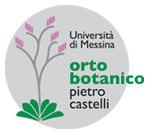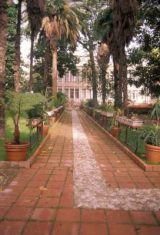In questo viale potete osservare e sentire al tatto, in un percorso didattico, alcuni aspetti significativi del mondo vegetale: l’evoluzione, gli adattamenti ai diversi ambienti, l’importanza delle piante nella vita quotidiana.
Sono esposte 65 specie per ciascuna delle quali è indicato il nome comune, il nome scientifico, la famiglia di appartenenza e il luogo di origine.
In sequenza troviamo: felci, Gimnosperme arcaiche (Cycas e Zamia) e Conifere; arbusti e piante erbacee della flora mediterranea. E ancora: piante da fibra (Ramiè e Formio), piante ricche di olii essenziali (Lavanda e Pelargoni), agrumi, piante aromatiche (Melissa, Salvia, Menta, etc.), piante dei nostri giardini (Pittosporo, Tibouchina, Liriope, etc.) e piante che si tengono in casa (Spatifillo, Yucca, Camedorea, etc.). Per finire un settore è dedicato alle piante succulente (Crassula, Semprevivo, Haworthia, etc.), espressione di un adattamento all’aridità.
Le etichette sono state realizzate grazie ad una collaborazione con il Comune di Messina nell’ambito del progetto Health&Greenspace.
Educational path with labels in black and in brilliants
In this avenue you can observe and feel, in an educational path, some significant aspects of the plant world: evolution, adaptations to different environments, the importance of plants in daily life.
65 species are exhibited for each of which the common name, the scientific name, the family of belonging and the place of origin are indicated.
In sequence we find: ferns, archaic Gymnosperms (Cycas and Zamia) and Conifers; shrubs and herbaceous plants of the Mediterranean flora. And again: fiber plants (Ramiè and Formio), plants rich in essential oils (Lavender and Pelargonium), citrus fruits, aromatic plants (Melissa, Sage, Mint, etc.), plants from our gardens (Pittosporo, Tibouchina, Liriope, etc.) and plants that are kept indoors (Spathiphyllum, Yucca, Camedorea, etc.). Finally, a sector is dedicated to succulent plants (Crassula, Semprevivo, Haworthia, etc.), an expression of an adaptation to dryness.
The labels were created thanks to a collaboration with the Municipality of Messina as part of the Health & Greenspace project.

